
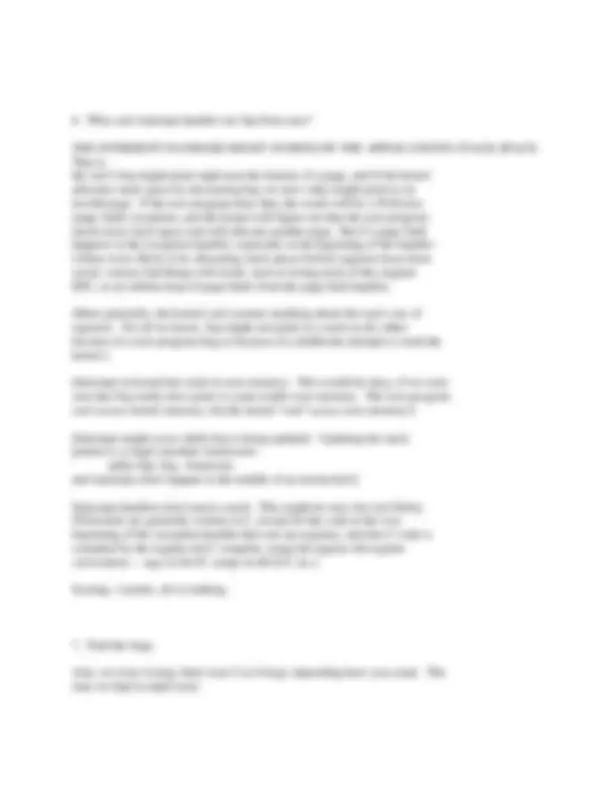
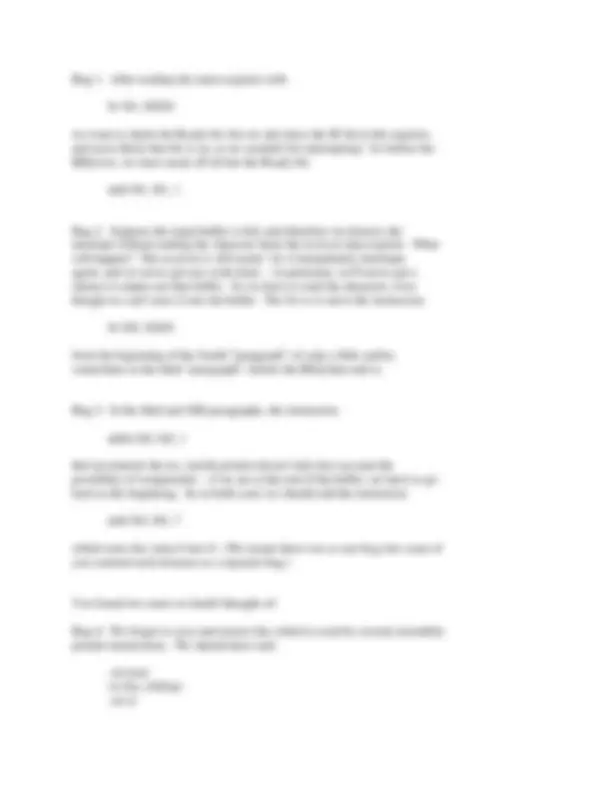
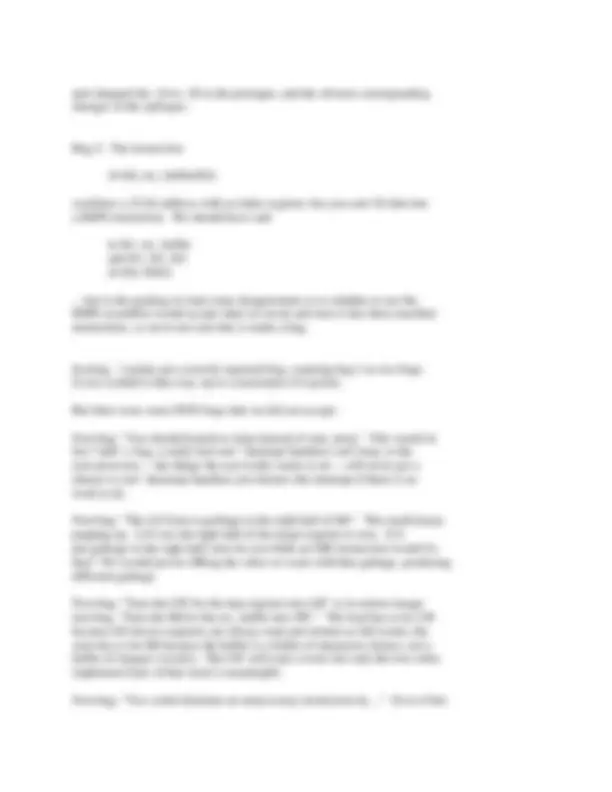
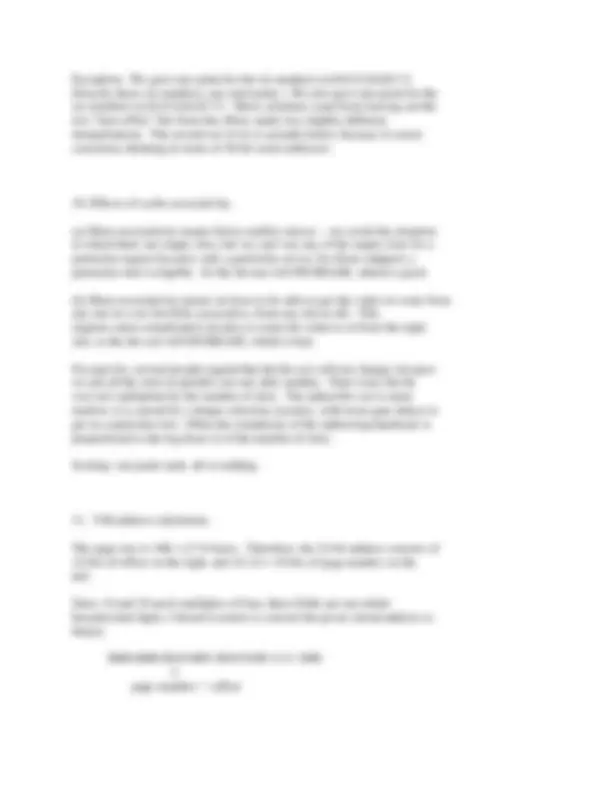
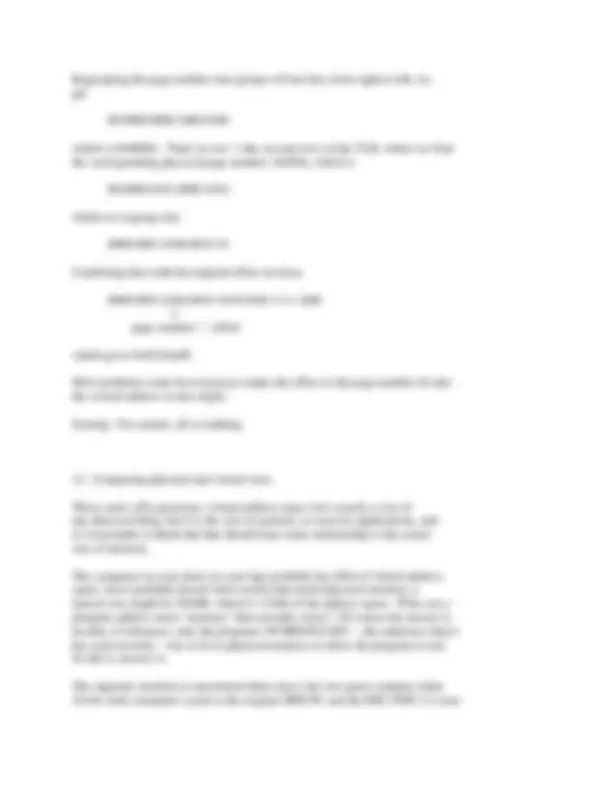
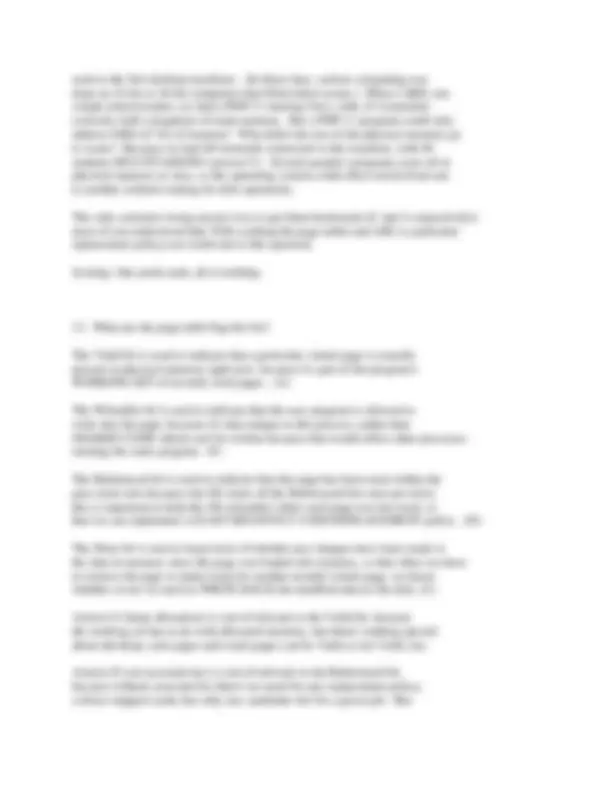


Study with the several resources on Docsity

Earn points by helping other students or get them with a premium plan


Prepare for your exams
Study with the several resources on Docsity

Earn points to download
Earn points by helping other students or get them with a premium plan
Community
Ask the community for help and clear up your study doubts
Discover the best universities in your country according to Docsity users
Free resources
Download our free guides on studying techniques, anxiety management strategies, and thesis advice from Docsity tutors
The role of registers $1 and their special purpose in mips assembly language. It also introduces the network protocol stack and its different levels, including http at the application level and ip at the network level. Additionally, it discusses the importance of not using the user's stack in interrupt handlers and the concept of virtual memory, including page table flag bits and their functions.
Typology: Exams
1 / 11

This page cannot be seen from the preview
Don't miss anything!







CS 61C Fall 2003 Midterm 2 solutions
The assembler. $1 ($at) is reserved for use by MIPS pseudo-instructions that are translated by the assembler into multiple MIPS machine language instructions. Most registers are allocated by the compiler to hold temporary or long-term values, but a few have special purposes, and $1 is one of those.
One point, all or nothing.
COMPUTE BRANCH OFFSETS. The assembler does this. The relocation process doesn't change the offset, because both the branch instruction itself and the instruction to which it branches are moved, so the distance between them doesn't change.
[RELOCATION is the linker's main job: Each .o file thinks it starts at address zero, and the linker moves each one to its own actual starting address (code and data separately, etc.).]
[COMBINE .O FILES is the reason relocation is necessary; that's what the "link" in "linker" means -- to combine things.]
[RESOLVE EXTERNAL SYMBOLS is also part of the combining process, so that the .o files can refer to each other.]
Scoring: Two points, all or nothing.
The seek time is the amount of time needed before a read or write operation can begin. A small seek time is good. Disk A has the smaller seek time.
The transfer rate is the speed with which data can be read or written once the operation begins. A large transfer rate is good (it's the speed, not the time required). Disk B has the larger transfer rate.
For small files, the startup time is most important, because we'll do many small operations. So disk A is the better choice.
For large, contiguous files (it's important that they're contiguous because then the entire file can be handled in a single transfer), the transfer rate
is most important, because there will be fewer operations, but each operation will take longer. So disk B is better.
Scoring: one point each, all or nothing.
The bottom of the stack is low in abstraction level, dealing directly with hardware; the top is highest in abstraction, working in terms of a single (virtual) network with reliable worldwide connections:
Application level: Mail, FTP, Instant Message, HTTP (Web browser), etc.
Transport level: Adds reliability to worldwide Internet: TCP and UDP (TCP provides ongoing streams of in-order bits; UDP provides single packets.)
Network level: Adds worldwide connection through multiple physical nets: IP (Internet Protocol)
Link level: Device drivers for local network hardware: Ethernet, Token Ring, Wireless, etc.
So TCP=Transport, HTTP=Application, IP=Network, Ethernet=Link, UDP=Transport.
Scoring, 2 points, minus 1/2 point per error, but no less than zero points.
125 bytes = 125*8 bits = 1000 bits. If the bandwidth is 1,000,000 bits per second, it takes 1/1000 second (1 millisecond) to send a packet.
The time for the round trip is 2 ms outbound latency 1 ms outbound packet 1 ms to prepare the ACK 2 ms inbound latency 1 ms inbound packet which adds up to a total of 7 milliseconds.
Scoring: 2 points, all or nothing. Since the question said "how long, in milliseconds" we accepted 7 without units specified, but we also accepted the same time expressed in other units, e.g., 7000 microseconds.
Bug 1. After reading the status register with
lw $t1, 0($t0)
we want to check the Ready bit, but we also have the IE bit in this register, and most likely that bit is on, or we wouldn't be interrupting! So before the BEQ test, we must mask off all but the Ready bit:
andi $t1, $t1, 1
Bug 2. Suppose the input buffer is full, and therefore we dismiss the interrupt without reading the character from the receiver data register. What will happen? The receiver is still ready! So it immediately interrupts again, and we never get any work done -- in particular, we'll never get a chance to empty out that buffer. So we have to read the character, even though we can't store it into the buffer. The fix is to move the instruction
lw $t4, 4($t0)
from the beginning of the fourth "paragraph" of code a little earlier, somewhere in the third "paragraph", before the BEQ that ends it.
Bug 3. In the third and fifth paragraphs, the instruction
addiu $t2, $t2, 1
that increments the rec_nextIn pointer doesn't take into account the possibility of wraparound -- if we are at the end of the buffer, we have to go back to the beginning. So in both cases we should add the instruction
andi $t2, $t2, 7
which turns the value 8 into 0. (We meant these two as one bug, but some of you counted each instance as a separate bug.)
You found two more we hadn't thought of:
Bug 4: We forgot to save and restore $at, which is used by several assembler pseudo-instructions. We should have said
.set noat sw $at, 24($sp) .set at
and changed the -24 to -28 in the prologue, and the obvious corresponding changes in the epilogue.
Bug 5: The instruction
sb $t4, rec_buffer($t2)
combines a 32-bit address with an index register, but you can't fit that into a MIPS instruction. We should have said
la $t1, rec_buffer add $t1, $t1, $t sb $t4, 0($t2)
... but in the grading we had some disagreement as to whether or not the MIPS assembler would accept what we wrote and turn it into these machine instructions, so we're not sure this is really a bug.
Scoring: 2 points per correctly reported bug, counting bug 3 as two bugs if you counted it that way, up to a maximum of 6 points.
But there were some NON-bugs that we did not accept:
Non-bug: "You should branch to intrp instead of xmt_intrp." This would in fact add a bug, a really bad one! Interrupt handlers can't loop, or the user processes -- the things the user really wants to do -- will never get a chance to run! Interrupt handlers just dismiss the interrupt if there is no work to do.
Non-bug: "The LUI leaves garbage in the right half of $t0." This myth keeps popping up. LUI sets the right half of the target register to zero. If it put garbage in the right half, how do you think an ORI instruction would fix that? We would just be ORing the value we want with that garbage, producing different garbage.
Non-bug: "Turn the LW for the data register into LB" or its mirror image non-bug, "Turn the SB for the rec_buffer into SW." The load has to be LW because I/O device registers are always read and written as full words; the store has to be SB because the buffer is a buffer of characters (bytes), not a buffer of integers (words). The LW will read a word, but only the low-order (rightmost) byte of that word is meaningful.
Non-bug: "You could eliminate an unnecessary instruction by ..." Even if this
for break-even performance.
30 R + 230 - 230 R = 200 30 R + 230 = 230 R + 200 230 = 200 R + 200 30 = 200 R R = 30/200 = 3/20 = 15/100 = 0.15 = 15%
Scoring: 2 points, all or nothing.
The cache holds 64 Kb of data. Each cache slot contains 32 words, or 32*4 = 128 bytes. So there are 64K/128 = 1K/2 = 512 = 2^ cache slots. (Alternatively, 64K/128 = 2^16 / 2^7 = 2^9.)
Each cache slot has 128 = 2^7 bytes. So the offset field, which is used to find a byte or word within the slot, must be 7 bits, regardless of anything else about the cache geometry.
(P&H subdivide the offset into the byte offset within a word, which is always the rightmost two bits, and the word offset within a cache slot, which is 7- = 5 bits. This makes sense to a hardware designer because the bus is a word wide, so the processor always makes memory requests for a word, because that's all the bus will give you. The LB and SB instructions extract a single byte from the word internally, so the word offset and the byte offset are used by different parts of the hardware. Still, they're both selecting data from within a cache slot, so they're both part of the overall offset.)
(a) If the cache is direct mapped, a "set" is a single cache slot, so there are 2^9 sets, and so the index is 9 bits. This leaves 32-9-7 = 16 bits for the tag.
(b) If the cache is 4-way set associative, then there are 512/4 = 2^9/2^2 = 2^7 sets, so the index is 7 bits, and the tag is 32-7-7 = 18 bits.
(Yeah, we forgot to say that an address is 32 bits, but generally you made that assumption, which was what we intended.)
Scoring: One point, all or nothing, for 16,9,7 in part (a); one point, all or nothing, for 18,7,7 in part (b).
Exception: We gave one point for the six numbers (a)18,9,5;(b)20,7,5. (Exactly those six numbers, one total point.) We also gave one point for the six numbers (a)16,9,5;(b)18,7,5. These solutions came from leaving out the two "byte offset" bits from the offset, under two slightly different interpretations. The second set of six is actually better, because it's more consistent, thinking in terms of 30-bit word addresses.
(a) More associativity means fewer conflict misses -- we avoid the situation in which there are empty slots, but we can't use any of the empty slots for a particular request because only a particular set (or, for direct mapped, a particular slot) is eligible. So the hit rate will INCREASE, which is good.
(b) More associativity means we have to be able to get the value we want from any slot in a set (for fully associative, from any slot at all). This requires more complicated circuitry to route the value to or from the right slot, so the hit cost will INCREASE, which is bad.
For part (b), several people argued that the hit cost will not change, because we ask all the slots in parallel, not one after another. That's true; the hit cost isn't multiplied by the number of slots. The added hit cost is more modest; it is caused by a deeper selection circuitry, with more gate delays to get at a particular slot. Often the complexity of the addressing hardware is proportional to the log (base 2) of the number of slots.
Scoring: one point each, all or nothing.
The page size is 16K = 2^14 bytes. Therefore, the 32-bit address consists of 14 bits of offset on the right, and 32-14 = 18 bits of page number on the left.
Since 14 and 18 aren't multiples of four, these fields are not whole hexadecimal digits; I found it easiest to convert the given virtual address to binary:
0000 0000 0010 0001 0010 0100 1111 1000 /
page number / \ offset
used as the first desktop machines. (In those days, serious computing was done on 32-bit or 36-bit computers that filled entire rooms.) When I (BH) was a high school teacher, we had a PDP-11 running Unix, with, if I remember correctly, half a megabyte of main memory. But a PDP-11 program could only address 64Kb (2^16) of memory! Why didn't the rest of the physical memory go to waste? Because we had 40 terminals connected to this machine, with 40 students MULTITASKING (answer C). Several people's programs were all in physical memory at once, so the operating system could often switch from one to another without waiting for disk operations.
The only common wrong answer was to get them backwards (C and A respectively); most of you understood that TLB (caching the page table) and LRU (a particular replacement policy) are irrelevant to this question.
Scoring: One point each, all or nothing.
The Valid bit is used to indicate that a particular virtual page is actually present in physical memory right now, because it's part of the program's WORKING SET of recently used pages. (A)
The Writeable bit is used to indicate that the user program is allowed to write into the page, because it's data unique to this process, rather than SHARED CODE which can't be written because that would affect other processes running the same program. (F)
The Referenced bit is used to indicate that this page has been used within the past clock tick (because the OS clears all the Referenced bits once per tick); this is important to help the OS remember when each page was last used, so that we can implement a LEAST-RECENTLY-USED REPLACEMENT policy. (D)
The Dirty bit is used to keep track of whether any changes have been made to the data in memory since the page was loaded into memory, so that when we have to remove the page to make room for another needed virtual page, we know whether or not we need to WRITE BACK the modified data to the disk. (C)
Answer G (heap allocation) is sort-of relevant to the Valid bit, because the working set has to do with allocated memory, but there's nothing special about the heap; code pages and stack pages can be Valid or not Valid, too.
Answer H (set associativity) is sort-of relevant to the Referenced bit, because without associativity there's no need for any replacement policy; a direct mapped cache has only one candidate slot for a given job. But
set associativity is for caches, not VM, in which pages of physical memory are always fully associative.
Answers B and E aren't even close. Virtual memory never uses write-through, and if it did, pages would never be dirty. And if we used random page replacement, we wouldn't care which pages have been referenced recently.
Scoring: 1/2 point each, all or nothing.